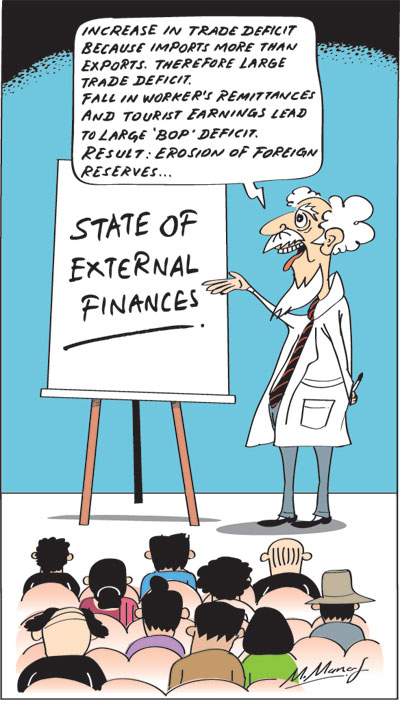Columns
Trade and balance of payments prospects this year
View(s): The trade and balance of payments outcome this year are critical for the country’s external financial stability. Although it is difficult to predict the balance of payments (BOP) outcome at the end of 2020, it is fairly certain the BOP deficit would increase from that of last year and make a dent in the foreign reserves.
The trade and balance of payments outcome this year are critical for the country’s external financial stability. Although it is difficult to predict the balance of payments (BOP) outcome at the end of 2020, it is fairly certain the BOP deficit would increase from that of last year and make a dent in the foreign reserves.
BOP deficit and debt
A balance of payments deficit of less than US$ 2 billion this year would be acceptable in the current global economic context. However, even with such a deficit the Government would need to obtain relief on debt repayment obligations through moratoria on debt repayment and assistance from friendly countries and multilateral agencies to tide over the debt repayment of this year and in 2021.
Last Year
In 2019 the trade deficit narrowed to nearly US$ 8 billion owing to a significant decline in imports and a slight increase in exports. This reduced the trade deficit by US$ 2.3 billion and enabled a small balance of payments surplus of US$ 377 million. In contrast, the balance of payments deficit was US$ 1.1 billion in 2018, when the trade deficit was US$ 10.3 billion. This underscores the importance of reducing the trade deficit.
 This Year
This Year
This year’s trade deficit may not increase by much owing to a further decrease in imports. Nevertheless the sharp decreases in tourist earnings and workers’ remittances will undoubtedly result in a large balance of payments deficit in 2020. Containing this year’s trade deficit would ensure the balance of payments deficit does not widen further, and erode the country’s foreign reserves that were at a comfortable US$ 7.5 billion at the end of March 2020.
Trade and BOP deficit 2020
Although it is hazardous to predict this year’s trade deficit due to the uncertainty of when the global economy would begin functioning normally, it is realistic to expect a larger trade deficit owing to lower exports. It is even more likely that there would be a large balance of payments deficit owing to the sharp decrease in earnings from tourism and lower workers’ remittances.
Exports
This year’s export earnings are likely to be much less than that of last year. Even though the export performance of the first quarter of this year is not indicative of the rest of the year owing to it being mostly prior to the global economic dislocation due to the COVID-19 pandemic, exports performed badly in the first three months of this year compared to the same period last year. Exports fell by 16 percent from US$ 3156 million in the first quarter of 2019 to US$ 2650 in the first quarter of this year. Industrial exports fell by 14.4 percent, while agricultural exports decreased by 21.8 percent. In fact, all exports with the exception of minor agricultural exports fell.
Tea
Most disappointing has been the country’s tea production and exports. Tea export earnings decreased by 22 percent in the first quarter of this year. Although tea export prices have gained some momentum, the inability to enhance tea export surpluses due to lower production may result in lower tea export earnings.
Tea production
Tea production in the first four months of this year of 73.3 million kg was 23.7 million kg less than the 97.0 million kg of January-April 2019. Production in all three elevations decreased with low grown teas showing the highest deficit followed by high grown teas and medium grown teas.
tea production of 20.2 million kg in April 2020 was a decrease of 3.4 million kg compared to 23.6 million kg in April 2019. This was the lowest crop for the month of April since 1993 when only 18.3 million kg were produced.
Expectations
It is in this context that expectations of this year have to be realistically anticipated. Although there are signs of a recovery of some export industries in the second half of the year and certain adaptations may enhance new and diversified exports, it would be rather optimistic to expect an export growth this year.
Industries that are likely to enhance exports are rubber manufactures, hygienic apparel and seafood. The combined impact of these cannot be expected to exceed the export earnings of manufactures of last year. Agricultural exports too are unlikely to increase. The export performance of the next three quarters would be determined by the outcome of the global economic recession this year.
Imports
Some relief in the trade balance will undoubtedly come from further shrinkage of imports. There would be a decrease in expenditure on imports of all three categories of imports, especially of intermediate goods. These include raw materials for industry, lesser requirements in construction and the lower import expenditure on fuel imports.
Fuel imports
Annual average fuel imports constitute about 15-20 percent of total imports. The lesser import expenditure on fuel due to the combined effect of a lower demand for fuel for transport during the lockdown period, as well as the much lower international oil prices, would have a significant impact on decreasing fuel imports.
In the first quarter of this year fuel imports decreased owing to international fuel prices falling to US$ 37.7 per barrel. However, there is a possibility that the CPC may have imported much higher quantities than required in order to benefit from the depressed international price. In which case, this year’s fuel imports would be a saving for the subsequent years.
Fuel pricing
Maintaining petrol prices at the earlier level is a prudent fiscal and trade policy. It enhances much needed revenue for the Government and prevents an increase in import expenditure.
Balance of Payments
The Achilles’ heel in the balance of payments is the sharp decline in tourist earnings and workers’ remittances. Last year workers’ remittances of US$ 6.7 billion offset 80 percent of the trade deficits. This together with the lower tourist earnings of last year of US$ 3.5 billion amounted to US$ 10.2 billion that was more than the trade deficit of US$ 8.3 billion.
In contrast, both these sources of foreign earnings are expected to decrease sharply this year. Tourist earnings are expected to be as low as US$ 2 billion. Workers’ remittances are expected to fall precipitously with large numbers of Middle Eastern employees’ out of employment and returning to the country. In addition, the usual stream of new migrant labour to the Middle East will dry up.
Large BOP deficit
While it is difficult to estimate the decreased tourist earnings and workers’ remittances, there is no uncertainty that both of them would decrease precipitously. The implication of this is that the trade deficit would lead to a balance of payment deficit and, in turn, the balance payments deficit will erode the country’s foreign reserves.
Conclusion
All things considered it is vital that the trade deficit is contained by both revival of export earnings and a sharp decrease in import expenditure. It is only by containing the trade deficit to a limited amount that the balance of payments deficit could be contained at about US$ 2 billion.
Even this balance of payment deficit would be a serious strain in the country’s reserves and next years’ capacity to meet foreign debt repayment obligations of about US$ 4.5 billion. This is the underlying reason why it is vital that the Government negotiates for moratoria on debt repayments until the country’s external finances can be in a better position.


Leave a Reply
Post Comment